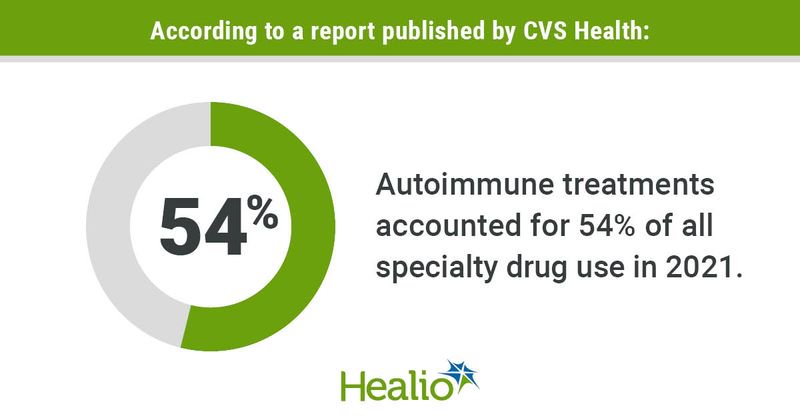Surge in specialty drug use ‘largely driven’ by autoimmune disease
Autoimmune treatments accounted for more than half of all specialty drug growth in 2021, according to a drug trend report released by CVS Health.
The report, published in late February, covers year-to-date Q3 2021 cost savings and trend data based on performance for commercial clients of CVS Health’s pharmacy benefit manager (PBM), CVS Caremark.

“In 2021, specialty growth was largely driven by utilization increases of specialty treatments in certain categories, including autoimmune and asthma/atopic dermatitis,” the report states, in part. “The increase in utilization was driven by new therapies and indications, as well as changes to guidelines for conditions like psoriasis and eczema that made more people eligible for treatment.”
According to the report, autoimmune drugs accounted for 54% of all specialty utilization trend, compared with 36% for asthma/atopic dermatitis, 6% for oncology, 2% infertility and another 2% for hormonal therapies.
In addition, the report states that the growth of autoimmune and asthma/atopic dermatitis classes has “largely stemmed” from increased use, not higher prices. According to CVS Health’s data, the use of autoimmune drugs has increased 8.8%, while prices have increased 0.9%.
According to Stephen B. Hanauer, MD, professor of medicine at the Northwestern University Feinberg School of Medicine, in Chicago, these data reflect the nature of autoimmune disease and its treatment.

“Biologics have made major impacts on the treatment of autoimmune diseases which, by their chronic nature, require maintenance treatment, indefinitely vs. any time limited treatments,” Hanauer told Healio.
‘The era of biosimilars is here’
The report also includes data on the current — and possible future — impact of biosimilars on the health care market. Declaring “the era of biosimilars is here,” it also states the PBM’s intentions with regard to how it chooses either biosimilars or reference products — it all comes down to cost.
“With some biosimilars on the market and more on the way, we expect — and are prepared for — a meaningful impact on specialty drug trend,” read the report, in part. “With biosimilars, as with all medications, our lowest net cost strategy applies. This means we’ll choose whatever is the lowest net cost option for the plan, which could be a biosimilar or a reference branded product.”
According to CVS Health data, the introduction of infliximab (Remicade, Janssen) biosimilars has driven down the price of the reference product by more than 50% in just 5 years. In January 2018, average sales prices for a 100 mg vial were $810 for Remicade, $712 for Inflectra (infliximab-dyyb; Pfizer, Celltrion) and $664 for Renflexis (infliximab-abda, Samsung), according to CMS figures cited in the report.
By January, those prices had been cut to $383 for Inflectra, $357 for Renflexis and $347 for Remicade.
A total of 14 new biosimilar approvals are expected from the FDA in 2022, which would increase the total number of approved biosimilars in the United States to 46, according to the report. Among the 32 currently FDA-approved biosimilars, only 21 are on the market, covering 10 unique drugs.
According to CVS Health, most of the 11 approved biosimilars that have failed to reach the market are for Humira (adalimumab, AbbVie) and Enbrel (etanercept, Amgen). Biosimilars for these drugs are expected to become available in 2023 and 2029, respectively.
“We’re already in proactive discussions on how new biosimilar options coming to market may impact our clients in the future,” the report states. “Once approved, we conduct new-to-market product reviews and ongoing evaluations to stay abreast of this evolving marketplace given its potential, positive impact to drug spending. As more specialty products lose marketing exclusivity over the next decade, the increase in both biosimilar and generic competition will have a material impact on the cost savings we can achieve for our clients.”
In this context, “clients” refers to health insurers, large employers and other payers, and not necessarily patients. According to Hanauer, individual patients currently see little, if any, cost savings from biosimilars, with most of their financial benefits going to insurers. He added that most patients who receive a biosimilar will do so because of decisions made either by the payer or their pharmacist, rather than their physician.
“Positive or negative the adoption of biosimilars will be for third party payers and pharmacists — if they interchange,” Hanauer said. “Doctors are not going to prescribe a biosimilar per se. They usually will prescribe the reference drug, which is then substituted by the payer — PBM — or, in case of interchangeable product, by the pharmacist.
“They will then be informed — or not in case of interchangeable product — that patient will be receiving a biosimilar,” he added. “Unfortunately, at the present time there is no ‘cost savings’ for individual patients. The savings will be for insurers. The reason that some reference products will be preferred by payers/PBMs is due to discounting and rebates.”

